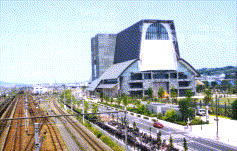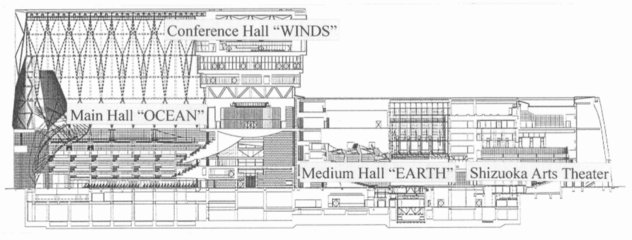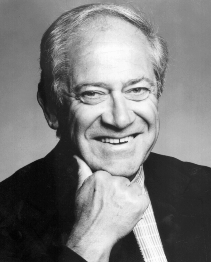
Title means "Quietness", "Comfortable Sound" and "Excellent Acoustics"
Nagata Acoustics News 99-6iNo.138j
Issued : June 25, 1999
"Granship" (Shizuoka Convention & Arts Center) "Sails Forth" as a New Home for Japanese Cultural, Sports and Other Events
by Satoru Ikeda
Location and Facilities Overview  |
Many travelers on the Shinkansen ("Bullet Train") ride from Tokyo to Osaka prefer a window seat so they can gaze at Mt. Fuji about 20 minutes into the ride. Now, passengers can also enjoy the quickly passing view of a new Japanese landmark: the huge Shizuoka Convention & Arts Center (nicknamed "Granship"). Riding on the super-fast Bullet Train, Granship appears about one hour after leaving Tokyo Station. Of course, the Bullet Train's first stop is yet another hour later, in Nagoya. But other trains running on parallel tracks do stop at the new JR Higashi Shizuoka Station that was built and opened in synch with the construction of the convention and arts center. The new station provides easy access to Granship.
Granship is located midway between Shizuoka City and Shimizu City, both in Shizuoka Prefecture. The objective of the complex is to be the most prominent cultural and information exchange center in Shizuoka Prefecture, and especially in the prefecture's eastern region. Like many governmental units in Japan, Shizuoka Prefecture region funds and sponsors a variety of projects to stimulate the region's economy and provide services to local citizens. Granship represents the region's most ambitious development project.
The top of Granship rises 60 meters high. The structure's exterior is finished in grey-green slate imported from Spain, and the overall shape bears some resemblance to a luxury ocean liner. As the epitome of a multipurpose facility, Granship boasts numerous and expansive facilities: a main hall that seats approx. 5,000; an 800~1200-seat, medium-size hall, and a 400-seat small hall, as well as a full-service, international conference hall and convention center.
From east to west (paralleling the tracks of the Bullet Train), Granship's oval-shaped shell extends approx. 200 meters in length. The small hall (named, Shizuoka Arts Theater) is at Granship's eastern-most end. Next is the medium-size hall (Earth), then the main hall (Ocean) at the building's western end. (These halls' names, "Earth" and "Ocean," are Japanese words referring to "earth" and "sea," respectively. They are complemented by the name of Granship's international conference hall--Kaze--which means "wind.")
Rehearsal and practice rooms can be found on the basement level underneath the three halls. Between the medium-size hall and the main hall rises a tower with other cultural, entertainment and convention facilities.
<< Granship's High-rise Tower >>
Facilities in the high-rise tower include a cinema, conversation lounges, galleries, and conference rooms. The tower's top floor features an international conference hall (Winds Hall). When the screen that covers the hall's large window is opened, Mt. Fuji appears in view.
Arata Isozaki & Associates created Granship's unique architectural design and served as project manager.
Layout of the halls and theater  |
<< Distinguishing Characteristics of the Large, Medium, and Small Halls >>
Each of Granship's main, medium and small halls was inspired by a different European hall. Ocean Hall's inspiration came from Royal Albert Hall. Earth Hall was inspired by Bayreuth Festspielhaus, and Shizuoka Arts Theater's design has roots in Shakespeare's Globe Theater. While Ocean Hall was inspired by Royal Albert Hall, its much larger size put limitations on its similarity to that hall. (It is not a colossal replica of the English hall.) The architectural objective is a forum where many people can come together, so another image that was invoked was the space of medieval cathedrals, as these structures also accommodated large numbers of people engaged in a single activity together.
<< The Main Hall -- Ocean Hall >>
Ocean Hall's 58-meter-high ceiling lets natural light shine in on this very large, level-floored hall. Stage, seats, lighting--everything in this hall can be moved and adjusted to a particular event's purpose. The stage can be raised or lowered. The seating is on air-caster palettes enabling a variety of seating patterns. The technical bridge can be moved and rotated. Blinds allow light to stream in or shut it out. The hall can be set up for exhibitions, fairs and sporting events. A stage can be raised at the hall's center and seating for 4,626 persons deployed to create a huge arena.
In a burst of creative foresight, the four 12-meter-high panel doors at the front of Ocean Hall were designed so they can be opened to the outside. Ocean Hall then faces onto the plaza in front of JR Higashi Shizuoka Station. With the doors open, the hall and plaza together provide an immense indoor/outdoor space.
<< The Medium Hall -- Earth Hall >>
Earth Hall seats either an audience of 747 persons as a theater for dramatic arts, or 1,209 persons as a lecture hall. This hall, which has a standard proscenium stage configuration, was designed for dual-purpose use as a convention hall or theater.
When Earth Hall is used as a theater, the floor of the proscenium stage is adjusted so that the front row seats are at the foot of the stage. When the hall is set up in this manner, movable side walls are deployed at the sides of the stage and some of the audience space is located there. While these audience seats are actually on the stage, they blend perfectly with the main audience seating.
Another special feature of Earth Hall's theater setup is its backstage area. This area extends far enough behind the stage that it can be used for set construction, as in a theater built exclusively for dramatic presentations. In addition, because the rear wall of Earth Hall is contiguous with the rear wall of the small Shizuoka Arts Hall, the backstage area is designed to be accessed and used by this hall, too. The design of the backstage area goes even one step further, allowing the movable back walls of each of the two halls to be opened so that the two halls can be used as one larger hall.
<< Shizuoka Arts Hall -- the Small Hall >>
Shizuoka Arts Hall is a theater-in-the-round seating 401 persons. It resembles a previous Arata Isozaki project, the ACM Theater in Art Tower Mito. However, Shizuoka Arts Hall improves on the earlier design with an expanded stage, the installation of functional stage mechanisms, more seating, and improved audience sight lines.
Unlike Granship's Ocean and Earth halls, Shizuoka Arts Hall is under the separate management of a local theater group, Shizuoka Performing Arts Center (SPAC), led by its Executive and Artistic Director, Tadashi Suzuki. This means that while Ocean and Earth halls will serve primarily as rental halls, Shizuoka Arts Hall will be the home of the SPAC theater and dance companies.
Shizuoka Prefecture already has a Performing Arts Park where theater and other groups stage performances. SPAC performs outdoors in the Park, and now has an exclusive, indoor venue for its dramatic and dance productions.
SPAC Japan creates its own plays and dance choreography. A major objective of the foundation is encouraging and fostering the education of talented actors, dancers, and other performance artists. It has both a theater company and dance company, and is the first non-profit cultural foundation of its scope and diversity in Japan.
<< Overview of the Project from an Acoustical Perspective >>
The multipurpose features of Granship meant that Nagata Acoustics' consulting work on this project was more like working on several projects than on just one. Overall, sound and vibration isolation from the nearby Bullet Train line and JR railroad line, as well as each room's sound and vibration isolation from other Granship facilities, were ever-present considerations throughout the project.
Because the acoustical characteristics and intended uses of each hall are so different, each hall's room acoustics design and sound system was individually planned and designed specifically for the intended purposes and conditions of that hall.
<< Vibration and Sound Isolation Issues of Each Hall >>
In particular, some of the sound isolation issues we resolved were:
* What impact large volumes of sound generated by large-scale events in Ocean Hall would have on the top floor international conference hall.
* How to ensure sound isolation between Earth Hall and Shizuoka Arts Hall, which share a backstage area.
* How to ensure sound isolation between the three halls and nearby rehearsal and practice rooms.
* In Earth Hall, how to ensure isolation from the sound of people walking and/or objects being moved in the gallery located immediately above the hall.
Because of the great diversity of characteristics and uses among Granship's many facilities, sound isolation planning activities were an integral part of our work from the outset of the entire design process. Measurement tests we conducted at the completion of the project confirmed that we achieved virtually all of the sound isolation objectives we set for this project.
<< Reverberation Times >>
Ocean Hall's size and its nearly 60-meter-high ceiling gave us plenty to consider in designing this hall's room acoustics. We needed to control what would otherwise be overabundant reverberation and we needed to eliminate the possibility of noxious echoes. With air space rising more than 30 meters above the highest-possible audience seating, we needed to implement extensive and overall sound absorption measures, including sound-absorbing audience seating. Our efforts resulted in a reverberation time of 1.8 seconds (at 500 Hz, and with an audience of 4,600). This is an exceedingly low reverberation time for such a large space.
Both Earth Hall and Shizuoka Arts Hall will primarily be used for theatrical performances. Therefore, we planned and achieved moderate reverberation times for both of these facilities.
<< Granship Chosen for Second Theatre Olympics >>
No sooner was Granship opened, than it was quickly chosen as the site for the second Theatre Olympics. This international event brings together play directors, including Japan's Tadashi Suzuki, to direct plays on a given theme. The first Theatre Olympics was held in Greece in 1995. At that event, the plays were staged in an ancient outdoor theater, and the theme was "Tragedy." The second Theatre Olympics was staged at Granship's three new halls and Shizuoka Performing Arts Park, allowing participating directors four different theater options. The theme of the plays for the second Theatre Olympics was "Creating Hope."
<< From Building Completion to Grand Opening >>
Granship's structure and installation was completed in August 1998. The period from October 1998 to March 1999 was reserved for simulation tests of the hardware and software apparatus and mechanisms, development of the operational organization, test runs and announcement preparations. In March, Granship's Grand Opening "set sail." Some 70 events unfurled, seen by some 70,000 visitors.
<< April to June 1999: A Vibrant Second Theatre Olympics >>
In April, Theatre Olympics began its two months of performances, ending on June 13, 1999. During the Olympics, 24 dramatic, dance, opera, and Noh performances were staged. Symposiums and workshops were held. In total, 60,000 ticket holders came to this event at Granship. Japanese audiences were treated to many works of performing art never previously staged in Japan.
Director Tadashi Suzuki says that three things must attract the audience for the performing arts to take root in a regional location: the theater, the people who work in the theater, and the works performed. Shizuoka Prefecture now has a very special venue to match its special people and artistic creations. Hopefully, a successful future is in store.
For information on Granship, contact Shizuoka Prefecture Cultural Foundation, 79-4 Ikeda, Shizuoka City, Shizuoka Pref., Japan. Tel: +81-54-203-5716, or access Granship on the web at www.granship.or.jp.
Ernest Fleischmann Speaks in Japan
by Yasuhisa Toyota
ERNEST FLEISCHMANN |
Former Los Angeles Philharmonic Vice President and Managing Director Ernest Fleishmann was invited to speak in Japan and visited there in March of this year for that purpose. He gave two talks, one at Sapporo Concert Hall, in Sapporo (in the Kitahara Main Conference Hall), and one at Suntory Hall, in Tokyo. The theme of his talks was "The Music Scene in the 21st Century." The Japan Orchestra Association sponsored Mr. Fleishmann's talk in Tokyo, and Sapporo Concert Hall sponsored the talk at its own hall.
Almost 30 years, from 1969 until his retirement in March 1998, Ernest Fleishmann steered the Los Angeles Philharmonic to ever greater success. He oversaw the orchestra during a golden age of conductors: first Mehta, then Giulini, Previn and, finally, Salonen. In the two talks, Mr. Fleishmann drew upon his wealth of experience and distinguished accomplishments to share with Japanese audiences the salient concerns, challenges and strategies he anticipates for orchestras in the new millennium. Below is a summary of his two talks.
?. MAJOR FINANCIAL CHALLENGES
<< The Financial State of U.S. Orchestras as We Enter the 21st Century >>
In both talks, Mr. Fleishmann used hard numbers to explain the dire financial situation of orchestras in the United States. While more than 100 orchestras belong to the nationwide American Symphony Orchestra League, the revenues of just four of the member orchestras account for approximately half of the revenues of all members of the League combined. These four orchestras are located in Boston, New York, Chicago and Los Angeles. The sad financial plight of the remaining 96+ members of the League is obvious.
Moreover, if one digs a little deeper into the financial situation of the four top revenue-generating orchestras, a look at their balance sheets reveals that more than 50% of these orchestras' incomes are eaten up solely by their players' salaries. These are hard times for the major U.S. orchestras, and less prominent U.S. orchestras are constantly on the brink of financial crises.
<< The Changing Financial Base of European Orchestras >>
Compared with U.S. orchestras, which rely exclusively on ticket sales and contributions from the private sector, European orchestras have traditionally enjoyed the benefits of governmental support and subsidies. Recently, however, those subsidies have been drying up completely or decreased. Since European orchestras lack the marketing experience and expertise of their U.S. counterparts, European orchestras that receive cuts in their governmental backing face even more precarious financial circumstances than orchestras in the United States.
<< Japanese Orchestras Also Watch the Bottom Line >>
Japanese orchestras are similarly strapped for funds. All of Japan's orchestras must worry constantly about their financial situations, and the importance of successful marketing efforts is always a foremost consideration in any decisions that the orchestras make.
Because financial considerations now so often take center stage in the management of an orchestra--be it in the United States, Europe, or Japan--the orchestras need managing directors with different qualifications than in the past. Not only must a prospective director be versed in music and musical performance, he or she must be knowledgeable in the fields of economics, business management and finance, as well. Directors of major orchestras now routinely come to their positions holding advanced degrees in both music and a business discipline, such as economics or management.
??. HOW THE LOS ANGELES PHILHARMONIC MARKETS ITSELF
Having discussed the financial challenges facing orchestras today and in the coming century, Mr. Fleishmann turned to a discussion of the marketing techniques and strategies developed and implemented by the Los Angeles Philharmonic under his direction. Some of these are:
* Extensive market research. The Los Angeles Philharmonic contracts with professional market research organizations to analyze both audience preferences and the demographics of ticket purchasers.
* Innovative promotions. An example of a promotional activity is including a discount coupon for concert tickets inside a CD of the Philharmonic.
* Programs for diversified audiences. In addition to diversifying the music in season subscription programs, the Los Angeles Philharmonic offers short subscriptions of combinations of three or four concerts.
* Community presence. Both orchestra members and conductors proactively make themselves appreciated and known in the community by performing wherever and whenever possible.
In discussing the importance of community presence, Mr. Fleishmann emphasized the need for orchestras to recognize that they are members of their communities. Orchestras should not consider themselves to be something lofty and set apart from the community. Rather, orchestras should strive to become accepted within their communities as an integral and essential part of community life.
???. WHAT REALLY MATTERS: THE MUSIC AND THE CHILDREN
After Mr. Fleishmann spoke passionately about orchestras' financial challenges and the value of effective marketing, he ended on a different note. In strong words, he told his audiences never to let the management and marketing of orchestras become ends in themselves. Mr. Fleishmann said that, at the Los Angeles Philharmonic, it was not uncommon for those involved to have to pause, remind themselves of the true purpose of their work, and then refocus their thoughts and efforts. What is truly important, said Mr. Fleishmann, is the music. How to preserve the music that so enriches our lives and inspires us, and how to promote and foster this treasure, for Mr. Fleishmann these are the goals that we must always keep before us.
Mr. Fleishmann then added that orchestras should perform concerts with programs developed for children and young people. These are the audiences of tomorrow, and the Los Angeles Philharmonic takes its role in developing their interest very seriously. (In Japan, orchestras also travel to perform in schools. But these performances are done out of a sense of obligation, and it shows.) The Los Angeles Philharmonic prioritizes its concerts for children. Often, the Philharmonic's music director performs these concerts himself, and he does so for only 10~20% of his normal fee (an 80~90% discount!). In order to teach children to understand and love an orchestra, we need to give them the best, always. What is essential now is our dedicated focus on nurturing musical culture for the future.
Nagata Acoustics News 99-6iNo.138j
Issued : June 25, 1999
Nagata Acoustics Inc.
E-mail: info@nagata.co.jp





